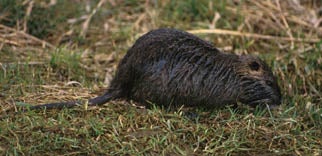SCIENTIFIC NAME:
Myocastor Coypus
OTHER NAMES:
Nutria, Swamp Beaver, Rat, Nutria Rat.
STATUS:
Exotic. Breeder. A South American native introduced into the United States for fur farming and weed control. Known to cause damage to crops, drainage systems, and natural plant communities.
DESCRIPTION:
A semi-aquatic rodent introduced from South America along the Gulf Coast of the United States in the 1930s. Coypu are large stocky rodents that are often mistaken as small beaver. Unlike the beaver, however, the coypu, also known as nutria, has a tail that is round and hairless -- thus the name “Rat” or “Nutria Rat.” The typical coloration is dark brown with long coarse guard hairs. The hind feet are webbed between the inner four toes, making this animal an excellent swimmer. The incisors are chestnut brown in color and extremely large. In many cases their incisors may be so large that they protrude past their lips. Weights of mature adults range from 20 to 25 pounds with males being slightly larger than females.
An interesting physical feature that nutria possesses is that their mammary glands are located along the sides of the back. This enables the young to nurse even when their mother is swimming about.
DISTRIBUTION:
One of the most widely distributed species along the coastal regions of the southeast. Historical records indicate that they were introduced into the Mobile Delta marshes of Alabama in September, 1948. In states such as Louisiana, nutria were introduced in the 1930s as a new furbearing species. These populations were scattered throughout southwest Louisiana and southeast Texas in 1941 as a result of a hurricane. Nutria in Alabama can be found from the Mobile Delta throughout much of the Alabama and Tombigbee Waterways.
HABITAT:
Similar to beavers including coastal swamps, brackish marshes, rivers, streams, back waters and ponds. These animals dig burrows for den sites in levees or stream banks. In swamp and marsh areas they feed and rest on platforms of vegetation built above the water.
FEEDING HABITS:
Similar to muskrat. Vegetation such as cattails, sedges, bulrush, reeds, roots and foliage of plants which are found in marshland habitat, are all consumed. Feeding habits vary considerably. They feed while in the water on floating objects or on land. In fact, nutria have been known to graze on grass like cattle and feed on upright plants like rabbits. They prefer the soft succulent parts near the base of plants and can live almost entirely on grasses such as Bermuda grass or on water plants such as duckweed.
LIFE HISTORY AND ECOLOGY:
Prolific furbearers, nutria become sexually mature at approximately eight to nine months of age and breed throughout the year. They do not mate for life; a female may breed with several males. Nutria will breed in and out of water. Under good conditions, they have a high reproductive rate. A female can produce two litters per year. After a gestation period of approximately 130 days, a litter of one to nine pups is born, with an average size of five. The young are born fully furred and with their eyes open. The young are weaned at approximately 5 to 7 weeks of age.
Nutria do not appear to be especially aggressive or wary. When disturbed they tend to flee instead of fight. Nutria feed and are most active at night, but will periodically feed during the daylight hours, depending on the availability of food.
REFERENCES:
Linscombe, G. 1980. The Fur Animals, the Alligator, and the Fur Industry in Louisiana. Louisiana Dept of Wildlife and Fisheries. pp. 69.
Sievering, M. E., 1989. Furbearers of Alabama. Alabama Department of Conservation and Natural Resources. Special Report No. 11. pp. 78.
Wade, D. A. and C. W. Ramsey. 1986. Identifying and Managing Aquatic Rodents in Texas: Beaver, Nutria and Muskrats. Texas Agriculture Extension Service. 46 pp.
Novak, M., J.A. Baker, M. E. Okford and B. Mallock. 1987. Wild Furbearer Management and Conservation in North America. Ontario Ministry of Natural Resources. pp. 1150.
Author:
Mike Sievering






